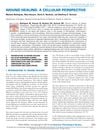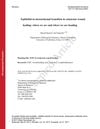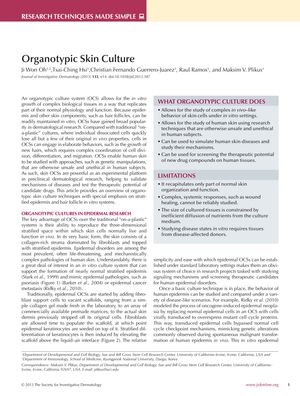TLDR Organotypic culture systems can grow skin tissues that mimic real skin functions and are useful for skin disease and hair growth research, but they don't fully replicate skin complexity.
The document described the use of organotypic culture systems (OCS) for the in vitro growth of skin tissues, highlighting their ability to mimic certain physiological functions of skin, including hair growth. It detailed the process of creating epidermal OCS by seeding keratinocytes on a scaffold with fibroblasts and inducing stratification. The document also noted the potential of OCS for studying human skin diseases and for preclinical anti-alopecia research, as hair follicles can be cultured to grow hair for up to two weeks. Despite their advantages, OCSs were acknowledged to have limitations, such as not fully replicating skin complexity and challenges in studying systemic responses. The document mentioned emerging technologies aimed at addressing these limitations and stressed the importance of validating OCS findings with in vivo studies.
13 citations
,
October 2010 in “Methods in molecular biology” Hair follicle culture helps study cell interactions and effects of substances on tissue growth.
132 citations
,
September 2009 in “Experimental Dermatology” A reliable system was developed to distinguish hair growth stages, aiding in identifying hair growth promoters or inhibitors.
385 citations
,
November 1990 in “Journal of Cell Science” Human hair follicles can grow in a lab setting.
 1160 citations
,
November 2018 in “Physiological Reviews”
1160 citations
,
November 2018 in “Physiological Reviews” The document concludes that better targeted treatments are needed for wound healing, and single-cell technologies may improve cell-based therapies.
18 citations
,
January 2013 in “Journal of Investigative Dermatology” WIF1 helps keep skin stem cells inactive to prevent excessive cell growth.
 1 citations
,
July 2023 in “Journal of visualized experiments”
1 citations
,
July 2023 in “Journal of visualized experiments” The new method makes it easier to study the whole cochlea from newborn mice and rats in the lab.
 299 citations
,
January 2018 in “Journal of Clinical Investigation”
299 citations
,
January 2018 in “Journal of Clinical Investigation” Different types of fibroblasts play various roles in diseases and healing, and more research on them could improve treatments.
 141 citations
,
August 2017 in “Developmental Dynamics”
141 citations
,
August 2017 in “Developmental Dynamics” The document concludes that a better understanding of cell changes during wound healing could improve treatments for chronic wounds and other conditions.




